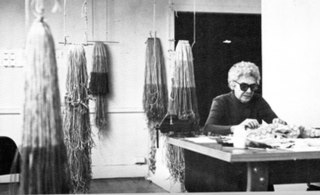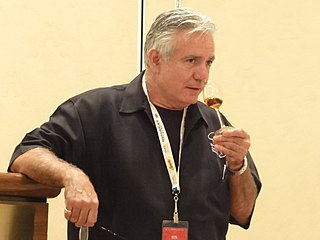
Wearable art, also known as Artwear or "art to wear", refers to art pieces in the shape of clothing or jewellery pieces. These pieces are usually handmade, and are produced only once or as a very limited series. Pieces of clothing are often made with fibrous materials and traditional techniques such as crochet, knitting, quilting, but may also include plastic sheeting, metals, paper, and more. While the making of any article of clothing or other wearable object typically involves aesthetic considerations, the term wearable art implies that the work is intended to be accepted as an artistic creation or statement. Wearable art is meant to draw attention while it is being displayed, modeled or used in performances. Pieces may be sold and exhibited.

Lenore Tawney was an American artist working in fiber art, collage, assemblage, and drawing. She is considered to be a groundbreaking artist for the elevation of craft processes to fine art status, two communities which were previously mutually exclusive. Tawney was born and raised in an Irish-American family in Ohio and moved to Chicago to start her career. In the 1940's and 50's, she studied art at several different institutions and perfected her craft as a weaver. In 1957, she moved to New York where she maintained a highly successful career into the 1960's. In the 1970's Tawney focused increasingly on her spirituality, but continued to make work until her death.

Claire Zeisler was an American fiber artist who expanded the expressive qualities of knotted and braided threads, pioneering large-scale freestanding sculptures in this medium. Throughout her career Zeisler sought to create "large, strong, single images" with fiber. Zeisler's non-functional structures were constructed using traditional weaving and avant-garde off the loom techniques such as square knotting, wrapping, and stitching. Zeisler preferred to work with natural materials such as jute, sisal, raffia, hemp, wool, and leather. The textiles were often left un-dyed, evidence of Zeisler's preference for natural coloration that emphasized the fiber itself. When she used color, however, Zeisler gravitated towards red.

Colab is the commonly used abbreviation of the New York City artists' group Collaborative Projects, which was formed after a series of open meetings between artists of various disciplines.

John Axel Prip, also known as Jack Prip (1922–2009), was an American master metalsmith, industrial designer, and educator. He was known for setting standards of excellence in American metalsmithing. His works and designs have become famous for bringing together the formal, technical tradition of Danish design into harmony with the American desire for innovation. Several of his designs for the Reed and Barton Company are still in production today.
Judith Schaechter is a Philadelphia-based artist known for her work in the medium of stained glass. Her pieces often use symbolism from stained glass and Gothic traditions, but the distorted faces and figures in her work recall a 20th century German Expressionist painting style and her subject matter is secular. Shaechter's work often involves images that might be considered disturbing such as death, disease, or violence. Early Schaechter pieces, for example, such as King of Maggots and Vide Futentes make use of memento mori, symbols of death found in church architecture during medieval times.

Dale DeGroff, also known as "the King of Cocktails" or "King Cocktail", is an American bartender and author. The New York Times in 2015 called DeGroff "one of the world's foremost cocktail experts", and wrote that his book The Craft of the Cocktail is considered an essential bartending reference. From 1987 to 1999 DeGroff rose to prominence as the original chief bartender in the Rainbow Room at Rockefeller Center in New York City, where his then-unusual emphasis on classic cocktail recipes and high-quality ingredients led to substantial acclaim and emulation by many other bars in New York City and beyond, and helped influence the creation of the craft cocktail movement.

Nick Cave is an American sculptor, dancer, performance artist, and professor. He is best known for his Soundsuit series: wearable assemblage fabric sculptures that are bright, whimsical, and other-worldly, often made with found objects. He also trained as a dancer with Alvin Ailey and often incorporates dance and performance into his works. His later sculptures have focused on color theory and included mixed media and large-scale installations. He lives in Chicago, Illinois, and directs the graduate fashion program at the School of the Art Institute of Chicago. He continues to work on Soundsuits as well as works completed as a sculptor, dancer, and performance artist.

Roberta Smith is co-chief art critic of The New York Times and a lecturer on contemporary art. She is the first woman to hold that position.

Sonya Clark is an American artist of Afro-Caribbean heritage. Clark is a fiber artist known for using a variety of materials including human hair and combs to address race, culture, class, and history. Her beaded headdress assemblages and braided wig series of the late 1990s, which received critical acclaim, evoked African traditions of personal adornment and moved these common forms into the realm of personal and political expression. Although African art and her Caribbean background are important influences, Clark also builds on practices of assemblage and accumulation used by artists such as Betye Saar and David Hammons.
Linda MacNeil is an American abstract artist, sculptor, and jeweler. She works with glass and metal specializing in contemporary jewelry that combines metalwork with glass to create wearable sculpture. Her focus since 1975 has been sculptural objets d’art and jewelry, and she works in series. MacNeil’s jewelry is considered wearable sculpture and has been her main focus since 1996.

Rosanne Somerson is an American-born woodworker, furniture designer/maker, educator, and former President of Rhode Island School of Design (RISD). An artist connected with the early years of the Studio Furniture, her work and career have been influential to the field.

Dindga McCannon, born on July 31, 1947, is an African-American artist, fiber artist, muralist, teacher author and illustrator.
Beverly Semmes is an American artist based in New York City who works in sculpture, textile, video, photography, performance, and large-scale installation.
Kay Sekimachi is an American fiber artist and weaver, best known for her three-dimensional woven monofilament hangings as well as her intricate baskets and bowls.

The Boating Party is an 1893 oil painting by American artist Mary Cassatt. It has been in the collection of the National Gallery of Art since 1963.
Dominic L. Di Mare is an American artist and craftsperson, known for his weaving, abstract mixed-media sculpture, watercolor paintings, cast paper art, and fiber art. His work touches on themes of personal spirituality. He is based in Tiburon, California.
Susanna E. Lewis was an American fiber artist, teacher and author known for her contributions to the Art to Wear movement.
Judith Kapstein Brodsky is an American artist, curator, and author known for her contributions to feminist discourse in the arts. She received her B.A. from Harvard University where she majored in Art History, and an M.F.A. from Tyler School of Art at Temple University. She is Professor Emerita in the Department of Visual Arts at Rutgers, State University of New Jersey. A printmaker herself, Brodsky is founding Director of the Rutgers Center for Innovative Print and Paper in 1996, later renamed the Brodsky Center in her honor in September 2006, and which later joined the Philadelphia Academy of Fine Arts (PAFA) in 2018. She was also co-founder, with Ferris Olin, of the Center for Women in the Arts and Humanities at Rutgers University in 2006. She was the first artist appointed as president of the Women's Caucus for Art, an active Affiliated Society of the College Art Association.
Charles Robert Winston (1915–2003) was an American jeweler, sculptor, and educator. He was known for his organic forms and sculptural jewelry in 1950s and 1960s. Winston was a co-founder of the Metal Arts Guild of San Francisco, a non-profit, arts educational organization. In 1997, he was honored as a Fellow of the American Craft Council.











